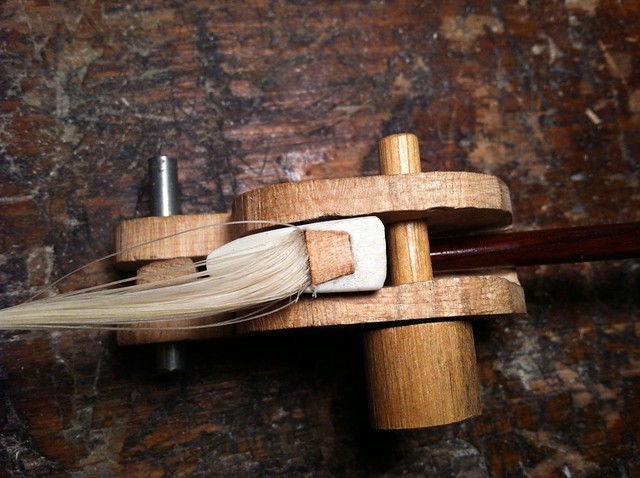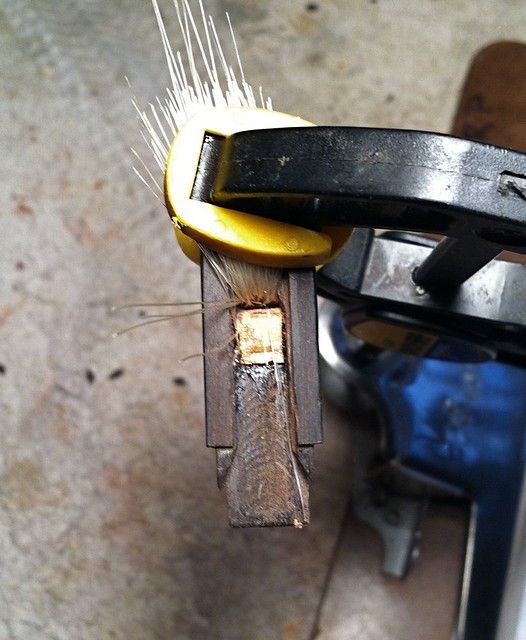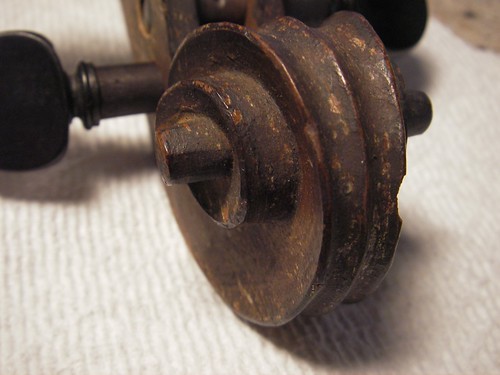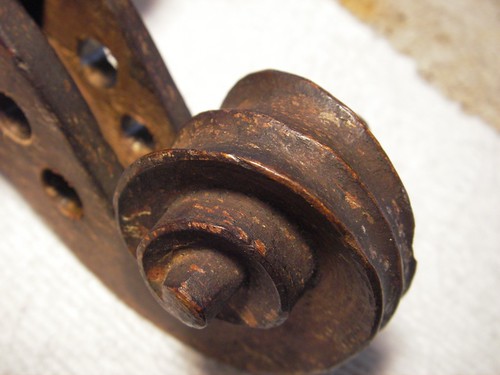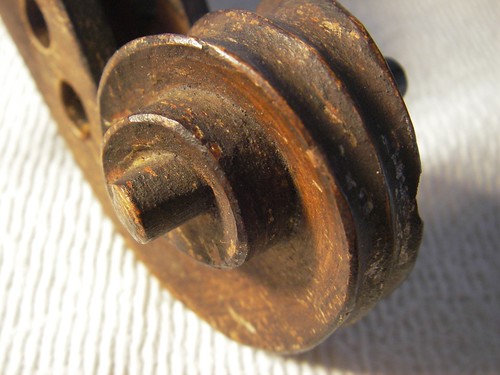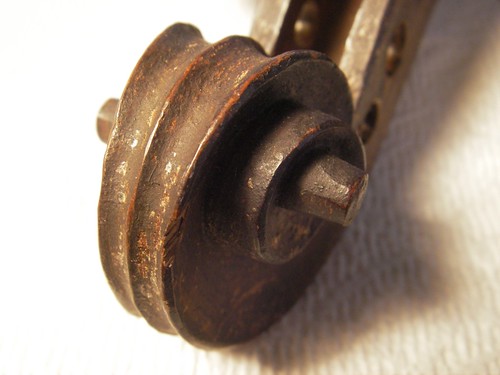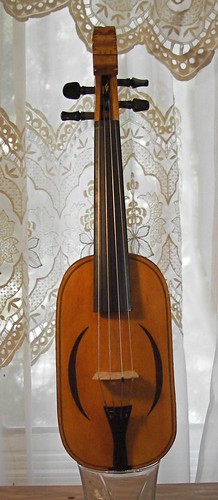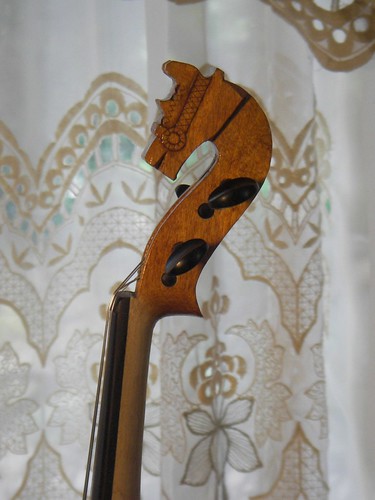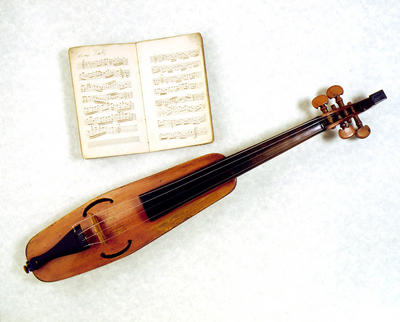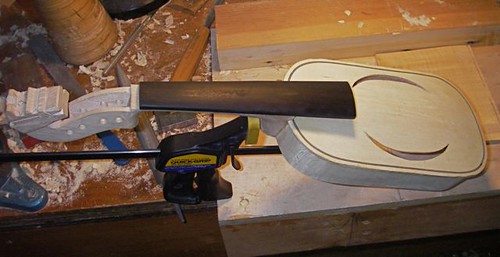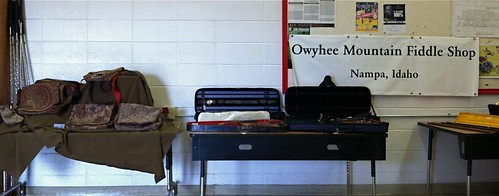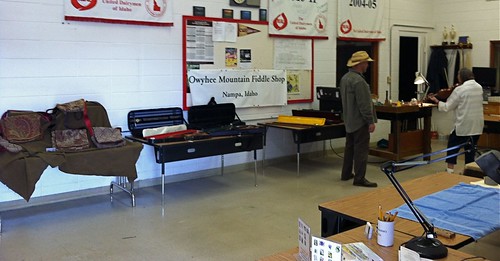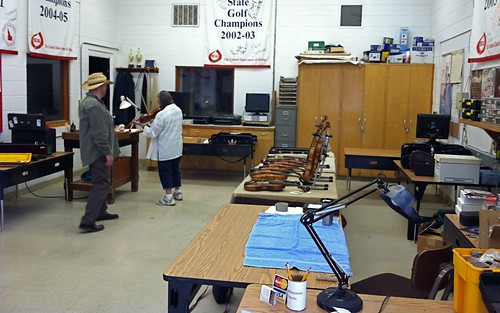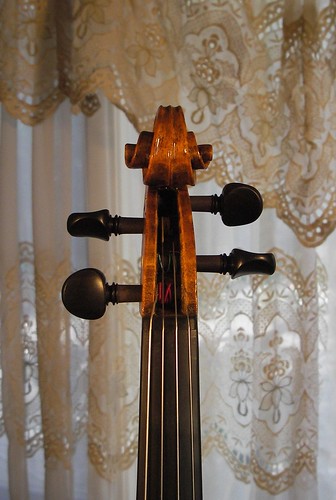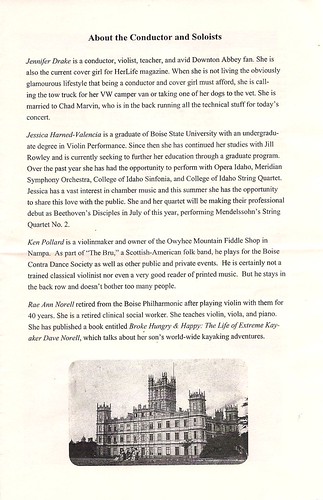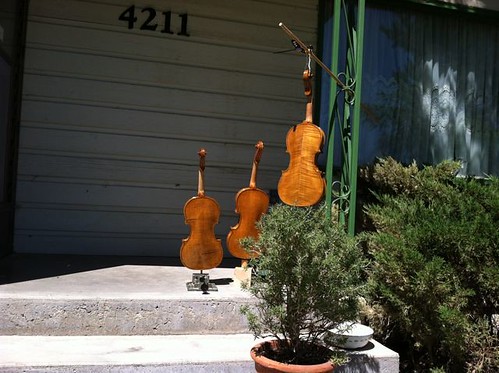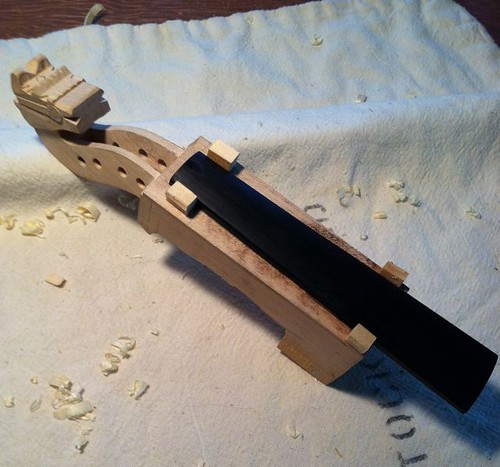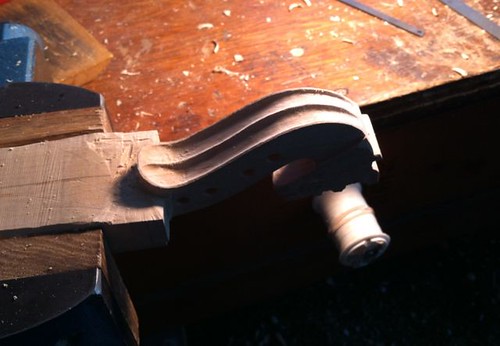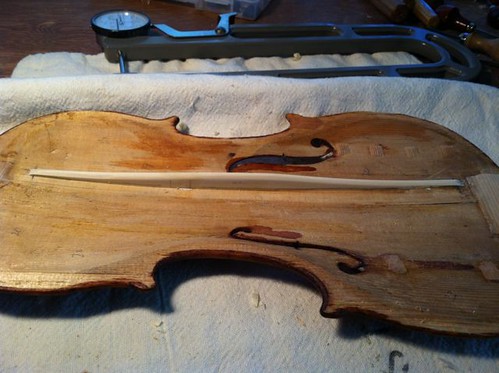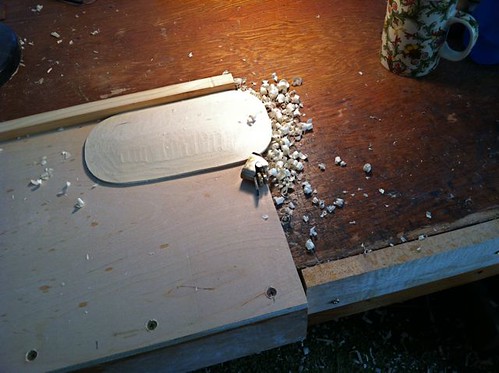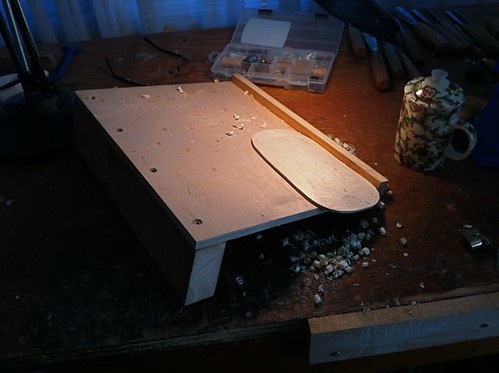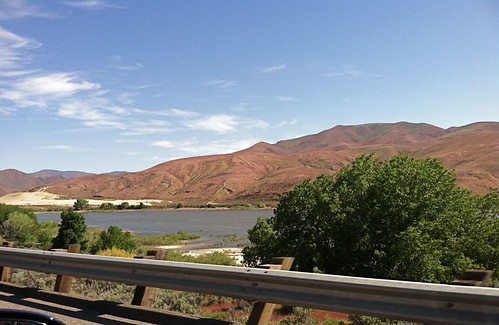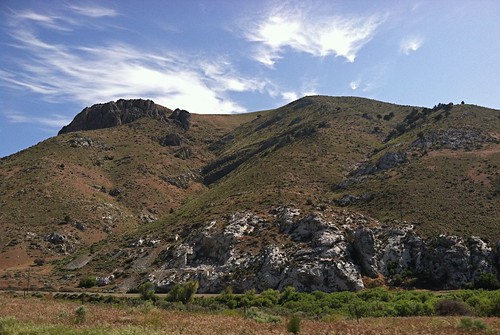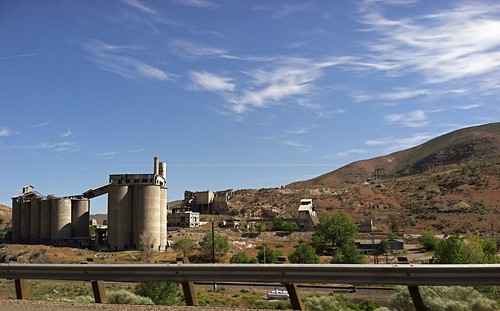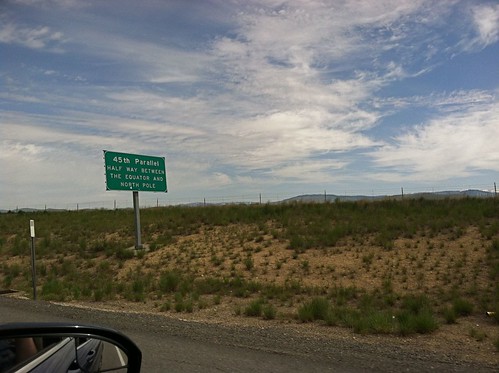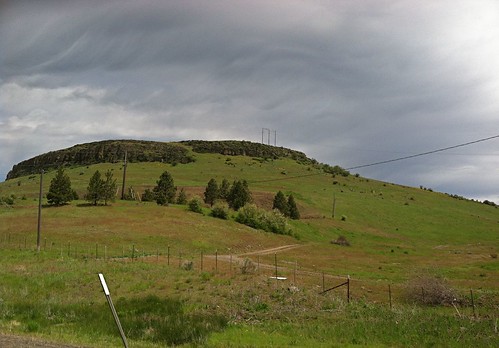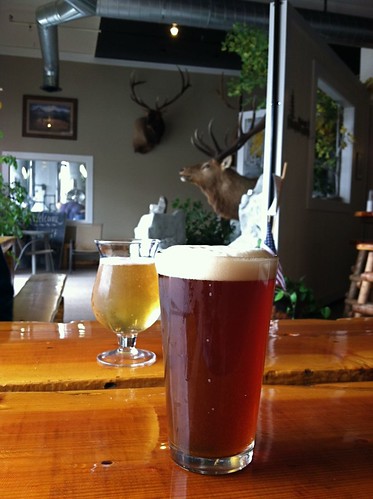Rehairing bows is something that most violin shops do. I do a few a month, in addition to violin repairs and making. It can be challenging, and humbling. Horse hair is used, which is organic and therefore variable. It has to be fit to the right length for each individual bow, and the length of hair changes with humidity and temperature. Not much, but even that can be too much in some situations. I try not to rehair on really rainy days, if I get the choice.
Another part of rehairing is the replacement of three little pieces of wood that are used to hold the hair in place. We are seeing more and more student bows done with, how shall we say?, not so much attention paid to these three little plugs. After all, the customer seldom sees them.
So, here are a few photos of the plugs of a recent rehair.
Here is the tip plug of a student-level violin bow. When done correctly, the plug is just the right size, held in by geometry. This one had a little glue to help it stay in place. Using the traditional invoked cursing 1-10 scale, 1 being none, 10 being the point at which you really need to repent later, this was about a 3.
Here is the ferrule wedge. It's not the best fitted one I've seen, but it did its job.
This plug holds the hair spread and is typically lightly glued in. You can see some of the glue that did not get wiped off. This one actually came apart fairly easy. Invoked cursing: 1.
For one that was rather loosely fit into the ferrule on the end, someone did take a little time shaping it. I'm not convinced this sort of shaping does much better than a straight taper, but it's pretty.
Here is a plug in the frog, holding the hair in that end. The clamp
holding the hair out the way is only for the photograph. This block,
when properly cut, stays in place through geometry and tension. As with many factory bows, this one
had a little glue in place for insurance. It's a little tougher to get out, due to its depth and the nearby edges. Invoked cursing 4 on this one. It came out without too much trouble after a bit of digging.
You can also notice the cutter marks showing in the cut-out of the throat.
And at the upper end, particularly the upper right, you can see a bit of roundness in the mortise. This is from the drill that was originally used to cut the mortise. The mortise should be rectangular, and it's ok to start with a circular hole, but you want to make it nice. This one was mostly rectangular, needing only a little cleaning up.
On the cheapest bows, it is a circular hole, with a piece of dowel glued in, instead of a shaped plug; invoked cursing 11. I try to remember which ones are like that, what they look like from the outside, and simply turn them down on a rehair. These Chinese bows often wholesale in the US at the $10-$20 dollar range and are sold in some stores at $70-$150. But, hey, they're real wooden bows.
What kind of wood? Dunno. But wood they are. Yup.
Wednesday, December 3, 2014
Tuesday, December 2, 2014
Waiter, there's a hair in my scroll
Cleaning up an old factory fiddle, a "Stainer" copy, and found this varnish-brush hair trapped down in a turn of the scroll.
It was fairly dirty in there, and I cleaned out a good layer of grime. For a while I thought the hair might be part of the gunk, but it was in the varnish, a left-over from the making process some hundred years ago.
The fiddle was a decent-sounding student instrument, and quickly went out the door as a rental.
It was fairly dirty in there, and I cleaned out a good layer of grime. For a while I thought the hair might be part of the gunk, but it was in the varnish, a left-over from the making process some hundred years ago.
The fiddle was a decent-sounding student instrument, and quickly went out the door as a rental.
Thursday, October 16, 2014
Factory Fiddle Scroll
Nothing special about this. It's a typical ca. 1900 "factory fiddle", probably from Germany. Labelled "Antonius Stradiuarius ... 1736".
I liked seeing the facets. Hastily carved, by someone who had carved a few, and was just trying to make a living. After that, the scroll itself has seen some use over the years.
Interesting character, I'd say.
Tuesday, September 16, 2014
Horsehead pochette
Strung it up today. String length is about 1/4-size violin. I experimented with various soundhole shapes, then finally decided to go modern/archaic. Viking longboat, with the curves being the upper and lower bouts. Top is spruce from near McCall, Idaho.
Back was an abondoned full-size violin back, European tonewood.
Neck is carved from a chunk of maple stock. Fingerboad is salvaged from an older fiddle. Width of the fingerboard is more normally full-sized, though the string length is 1/4.
Detail of horsehead. Inspired by photos I had seen of Norwegian Ale Bowls.
Source: https://www.flickr.com/photos/thorskegga/4105357103/in/faves-23218266@N06/
Full-size fiddle at back. "Glasgow ca. 1780" inspired kits on either side of the new horsehead kit.
More on the Glasgow kit: http://www.theglasgowstory.com/image.php?inum=TGSE00590
Back was an abondoned full-size violin back, European tonewood.
Neck is carved from a chunk of maple stock. Fingerboad is salvaged from an older fiddle. Width of the fingerboard is more normally full-sized, though the string length is 1/4.
Detail of horsehead. Inspired by photos I had seen of Norwegian Ale Bowls.
Source: https://www.flickr.com/photos/thorskegga/4105357103/in/faves-23218266@N06/
Full-size fiddle at back. "Glasgow ca. 1780" inspired kits on either side of the new horsehead kit.
More on the Glasgow kit: http://www.theglasgowstory.com/image.php?inum=TGSE00590
Thursday, July 17, 2014
The Shapes Seen by the Carver.
Transient and pretty. I think so, and if you're into any sort of wood carving, I suspect you do to. A little scene that lasts for a moment, then is gone.
This violin back plate is still several millimeters away from its final surface. The outside shape is not finished, the corners overgrown clumps that will slowly evolve. In the meantime, I like seeing the steps before the end, before the completion. At this stage, I am flailing away, taking off as much wood as I dare. I like seeing the leftovers, the curls of wood that will be swept up, destined for the fireplace, the compost heap, or the trash, depending on my whim at the time.
With luck, it will live a long life as part of a violin, making music, interacting with the human world. With more luck, someone will really enjoy its shape, its existence.
The scene here is obviously only potential. What will it look like? What will it sound like?
Permance, though, is perhaps nearly as fleeting.
This violin back plate is still several millimeters away from its final surface. The outside shape is not finished, the corners overgrown clumps that will slowly evolve. In the meantime, I like seeing the steps before the end, before the completion. At this stage, I am flailing away, taking off as much wood as I dare. I like seeing the leftovers, the curls of wood that will be swept up, destined for the fireplace, the compost heap, or the trash, depending on my whim at the time.
With luck, it will live a long life as part of a violin, making music, interacting with the human world. With more luck, someone will really enjoy its shape, its existence.
The scene here is obviously only potential. What will it look like? What will it sound like?
Permance, though, is perhaps nearly as fleeting.
Wednesday, July 16, 2014
Web-page Revision
I've made a minor, and at the same time, a major, change in my business's web-page. Focusing more on one-of-a-kind and my own instruments, I've decided to try listing some instruments and prices on my web-page.
This is brand-new today, and you can see it here.
Probably several changes to lay-out and format in the next few weeks. I am accustomed to making frequent, minor updates to the web-page, but this will probably require a bit more attention. And I have no idea how it will look on others' browsers.
It's really a guess on my part. By far, most of my business since 1996 has been local, walk-in, personal referral. Times change. It could be interesting.
Tangentially related, and because I like to see images on blog-posts, here's the neck attached to the body of my newest pochette.
I had intended to cut normal f-holes into this one, but no matter how I drew them, I didn't like them. Seemed busy. I was suddenly inspired by the Norwegian ale-bowl horsehead scroll to cut soundholes shaped like longboats. Another guess on my part. But it's just a fiddle.
This is brand-new today, and you can see it here.
Probably several changes to lay-out and format in the next few weeks. I am accustomed to making frequent, minor updates to the web-page, but this will probably require a bit more attention. And I have no idea how it will look on others' browsers.
It's really a guess on my part. By far, most of my business since 1996 has been local, walk-in, personal referral. Times change. It could be interesting.
Tangentially related, and because I like to see images on blog-posts, here's the neck attached to the body of my newest pochette.
I had intended to cut normal f-holes into this one, but no matter how I drew them, I didn't like them. Seemed busy. I was suddenly inspired by the Norwegian ale-bowl horsehead scroll to cut soundholes shaped like longboats. Another guess on my part. But it's just a fiddle.
Monday, June 30, 2014
The Retail World Today.
In our part of the country, we are seeing many stores closing. I suspect most of these closings are due to internet sales. I think the rate will accelerate.
We spent our week at Weiser this year a little differently. We had very little in the way of commonly available retail items, and, for the first time, I had no music books. In the past, I've spent many hours selling music books there. I enjoy books, and enjoy talking with folks who enjoy books. The problem is, there's no money in it now.
I had my handmade instruments, white instruments I had varnished, and vintage instruments. I offered repairs. Phil had his bows and offered rehairs and repairs. It was a much slower week as far as individual sales, but we did survive.
And how have the economics changed? Here is a cut-out from a flyer I received this morning, advertising a new string being offered by one of my wholesale suppliers.
The list price is the old "manufacturer's suggested retail price." Traditionally, this is what has been used to determine the wholesale price, the price I would pay for the set of strings. In the past, this has been roughly 50%, which in this case would be $35.00. As a "Special Introductory Sale Pricing," the set is being offered to me at 40%, or $28.26.
So what is the MAP? It is the Minimum Advertised Price. That is, it is the lowest price that can be advertised. Note that in the usual wholesale pricing, this is pretty darn close to the usual wholesale price.
With the sales-flyer email still fresh on my computer screen, I went to Amazon.com, and found this right away.
Note that Amazon's price is right at the MAP. Also note the "Prime," which means if you are an Amazon-Prime member, you don't have to pay shipping. I don't get the same deal from my wholesaler unless I buy many, many sets.
Further note the "More Buying Choices" at $31.50, below the MAP. How is this possible? Well, it turns out they are not actually the same strings, but similar. What would the customer choose? Who knows, but the option is there, 24-hours a day, 365 days a year.
What happens if a seller advertises at a price lower than MAP? They get in trouble. What does trouble mean? I don't know. I suspect not much. And note that the MAP is the lowest price a product can be advertised, not the lowest at which it can be sold.
So, how can I make money selling strings? I can't. So, I don't, or at least, not often. I have strings and will sell them, but mainly they are for my own work.
I am in the fortunate situation that I can make my living from repairs and building, lessons, some income from performances, that sort of thing -- all things that are really hard to do easily over the internet.
But, my income depends on other people making money, making a living, too. And there is a huge change happening which I suspect many people are not really aware of. Not a good time to be a brick-and-mortar store or employee.
Lesson: learn how to DO something.
Thursday, June 26, 2014
Marriage Marks
One thing we often see on vintage factory violin bows are Roman numerals on the underneath portion of the slide as well as on the stick. I've heard all sorts of explanations for these things, from price to maker's mark, and so on. But the most reasonable explanation, I think, is this: VII frog goes with VII stick, VIII frog goes with VIII stick. A maker in a factory would have several on his bench at one time, or even a partial assembly line set-up, with it moving along to another maker for the next step in production.
And today I ran across this --
Timber Frame "Marriage" Marks, found in the on-line publication "18th Century Material Culture: The Carpenter and his Tools - Framing."
A traditional technique, it turns out.
And today I ran across this --
Timber Frame "Marriage" Marks, found in the on-line publication "18th Century Material Culture: The Carpenter and his Tools - Framing."
A traditional technique, it turns out.
Monday, June 16, 2014
Weiser 2014
For more than a dozen years now, Phil Stanley and I have run the repair shop at the National Old-time Fiddlers Contest in Weiser, Idaho. We cram our little cars full of shop goods, tools, parts, and such, and make the hour-plus drive up to Weiser. We set-up in the shop room, out behind the warm-up area at the Contest. Good years and not-so-good in sales, but we always have fun. Lots of good friends new and old.
Here are a few iPhone snapshots of our set-up. This first one shows the debut of my wife's "Juniperberry" bags -- for music books, shoulder rests and general musical needs. She thinks of them as "Useful handmade bags with a touch of historic fantasy."
Here are a few iPhone snapshots of our set-up. This first one shows the debut of my wife's "Juniperberry" bags -- for music books, shoulder rests and general musical needs. She thinks of them as "Useful handmade bags with a touch of historic fantasy."
Here are is Phil, helping a customer with some bow trials.
Looking down the tables with instruments and bows on display. We have no music books this year for the first time in probably a dozen years; it's one thing that we just can't compete with Internet sales, so we're focusing on handmade and restored vintage instruments, one-of-a-kind items.
The blue towel covers my 'workbench' for the week. Actually end up doing a fair number of diverse repairs here. Keeps one on one's toes.
The three instruments in stands are violins I have made. The rest are whites that I have reworked and finished or vintage instruments I have restored.
Thursday, June 12, 2014
Latest fiddle strung up.
A few quick snapshots of my latest completed violin. This one is based on the Amati Brothers form I drew following Francois Denis' techniques. I tried to add some interesting color to the instrument, to give it some sort of illusion of age (or, in other words, grime). Not sure how well it worked. I'll see how many eyes land on it at Weiser next week.
A back shot, showing the diagnonal stripe in the two-piece back.
I strung it up last night, played it a half-hour or so, and again for 15 minutes or so this morning. Having heard the arguments pooh-poohing the concept of playing in, I believe it is a real effect. I can already hear a difference in it this morning. The last coat of varnish went on last week, and is not completely hard by any means. Being under tension, aging & curing, and (I believe) playing all help the fiddle learn how to be a fiddle.
A couple views of the scroll -- not to be confused with a machine-carved scroll! :-)
As we've done for the past dozen years or so, we'll be the repair shop at the National Oldtime Fiddlers Contest in Weiser, Idaho, which starts Monday (today being Thursday). I really need to get other things done before we're ready to go, including getting a few more instruments set-up, packed, signs made, and all the other nonsense that goes along with hauling a repair shop to another site.
But we have fun there.
If you're in the area, you can come in and see this fiddle, as well as others I've made. We'll be set-up in a classroom out behind the warm-up area in the high school.
A back shot, showing the diagnonal stripe in the two-piece back.
I strung it up last night, played it a half-hour or so, and again for 15 minutes or so this morning. Having heard the arguments pooh-poohing the concept of playing in, I believe it is a real effect. I can already hear a difference in it this morning. The last coat of varnish went on last week, and is not completely hard by any means. Being under tension, aging & curing, and (I believe) playing all help the fiddle learn how to be a fiddle.
A couple views of the scroll -- not to be confused with a machine-carved scroll! :-)
As we've done for the past dozen years or so, we'll be the repair shop at the National Oldtime Fiddlers Contest in Weiser, Idaho, which starts Monday (today being Thursday). I really need to get other things done before we're ready to go, including getting a few more instruments set-up, packed, signs made, and all the other nonsense that goes along with hauling a repair shop to another site.
But we have fun there.
If you're in the area, you can come in and see this fiddle, as well as others I've made. We'll be set-up in a classroom out behind the warm-up area in the high school.
Monday, June 9, 2014
Orchestral Soloist (for a full 30 seconds)
I am now an experienced orchestral soloist! :-)
Being a fiddle player who has always enjoyed classical music, I long ago thought that once the kids were grown and out of the house, I'd maybe find a community orchestra to join. See what it's like. As the kids and I got older, I realized that I probably just couldn't cut it in an orchestra -- all that bowing the same way, not haphazard like I do, for example.
It turned out, though, that last January, a few months after my youngest left home, the new director for the Serenata Chamber Orchestra, Jen Drake, invited me to participate. I couldn't let it pass.
This is my second concert with them, and it was a "Downton Abbey" themed event. One of the pieces was a couple tunes from the movie "The Titanic" (because in one of the early episodes of Downton Abbey, the Titanic sunk). And Jen asked me to play a fiddle break between the two orchestrated fiddle tunes in the piece. I played "The Rose in the Heather" -- all 32 bars, or effectively about 30 seconds. Really different for me, trying to figure out how to fit it in, and I'm not sure I did it the best way, but people had fun.
My wife managed to snap this photo during my solo.
From the concert's program, a bio-page of the soloists, including yours truly.
Thursday, June 5, 2014
New and old, progress at least.
With the semester of college teaching over, and Weiser on the near horizon, I'm actually getting a few things done. These 3 are essentially cured, and next to polish up the varnish a bit, then fit them up.
A stubby little fingerboard for a pochette.
Suddenly realized I hadn't fluted the back of the pochette scroll, so quickly dug in. Forgot to chamfer the sides first, so the outside edge will be lower than the center. Not my plan, but a common feature.
A stubby little fingerboard for a pochette.
Suddenly realized I hadn't fluted the back of the pochette scroll, so quickly dug in. Forgot to chamfer the sides first, so the outside edge will be lower than the center. Not my plan, but a common feature.
New bassbar in one of the old fiddles I'm fixing up for Weiser.
This is a customer instrument, typical of many student instruments of the late 1800s, early 1900s. Integral bassbar, false corner blocks (lower), Strad label, hair ball, horse hair, and strings ends floating around inside. Unusual round cleats holding the center seam. Some of these old horses work fine.
Wednesday, June 4, 2014
Bench Hook.
Earlier this year, I read a blog-post that made think -- "That is a marvelous idea. Why have I not thought of this or even heard about it before?"
Here is the link to that blog-post .
Finally with a little time to get something done, I threw one together with scrap I had around the shop. I made the main holding area wider than in the original post, because I want to use it for violin plates.
It's great.
I don't know that I have the optimal size -- this is literally from scarp around the shop. I had a piece of plywood that size next to the bench. I used a section of old 2x4 for the part that hooks over the bench, and a small piece of pine for the stop at the far end.
Here is the bench hook unhooked. Try it; you'll like it.
On the another front, I have a couple fiddles with their final coat of varnish on. My latest (left) and an earlier one which I have stripped and revarnished. Out catching some morning sun.
Monday, May 19, 2014
SpringAlive 2014 workshop, part 1
We traveled last weekend up to La Grande, Oregon, for the SpringAlive 2014 workshop. We've been several times in the past, and in the recent years have just really learned a lot from this event. It is a contradance workshop, covering both dance and music. I was involved in both parts -- fiddling and dancing -- so really didn't get any photos from the event itself. Others did, and I will write more on the workshop itself soon, hopefully also including a few photos.
But I thought I'd add here a few photos of the trip up. Monica drove, so I had the luxury of just watching the scenery, scenery I've seen so many times, so familiar to me, and yet seldom with the opportunity to actually look at it.
I decided to take a few photos with my phone. Not great quality, but maybe of some interest.
The first one here is at La Grande, Oregon, just across the border at the Snake River. I drive this way when going up to Weiser for the National Old-time Fiddlers Contest, and there is a little stretch of tributary river, right next to the freeway, which is so nicely wooded and tranquil that I always like seeing it. Unfortunately, the viewpoint is at the top of a freeway bridge with no place to stop. I tried to get 'the' shot, but failed. I did get a decent one of the nearby railroad bridge.
As a side-note, for those who eat such stuff, many of the country's Tater Tots are made at the little factory on the reverse side of the freeway. It's not so scenic, although it is fairly easy to spot a little steam 'smoke ring' coming out of one of the stacks.
Farewell Bend is the place where, in the old days, The Oregon Trail left the Snake River after following it for a few hundred miles. Following the Snake River downstream takes you through Hells Canyon, which, as the name suggests, isn't exactly wagon country. Nor freeway. It follows the Oregon Trail crossland here.
This shot is looking downstream towards Farewell Bend, though it's just out of sight on the left. Idaho is across the river.
And here's a shot that catches Farewell Bend on the right, and the entrance to Hells Canyon as the Snake veers downsteam towards the right of center.
As the Oregon Trail (aka I-84) continues cross country, we follow the Burnt River. This time of year, things are fairly green. When the Oregon pioneers came through, it would have been late summer, and fairly dry.
At the conveniently named Lime, Oregon, is an abandoned cement plant.
It's fairly interesting to look at, to my mind.
Between Baker City and Ontario, we pass a landmark that reminds us to be on good behavior because it's easier for Santa to see us now.
It's hard to tell in the photos here, but the Arrowleaf Balsamroot were in bloom. Yellow flowers, smell of vanilla.
Ladd Canyon is a relatively steep but short canyon the descends down to La Grande. In the winter time, it can be quite treacherous, and is sometimes closed. I spent a few days in La Grande one December, stuck between the closed freeway in Ladd Canyon on one side, the Blue Mountains on the other.
Here we are just about to descend into the Canyon.
So then we got to La Grande, secured our hotel room, and headed off to the workshop. A musicians workshop taught by Susan Songer and Lanny Martin of Portland, a dance workshop taught by David Kaynor of Massachusetts. Lots of good info. A potluck dinner, then the dance, where all the musicians got to play in the band.
Sunday morning I had an hour-long private fiddle lesson with David Kaynor. As I mentioned, I write more about the event itself in a following blog post. I will mention that it is a worthwhile event.
We headed on home, and once safely on the other side of the 45th Parallel, out of Santa's view, we had a beer with lunch at the Bull Ridge Brewery in Baker City, Oregon.
The "Bull" of Bull Ridge being bull elk. Lone Pine Lager in the rear, Sugarloaf IPA in the foreground.
Subscribe to:
Posts (Atom)

